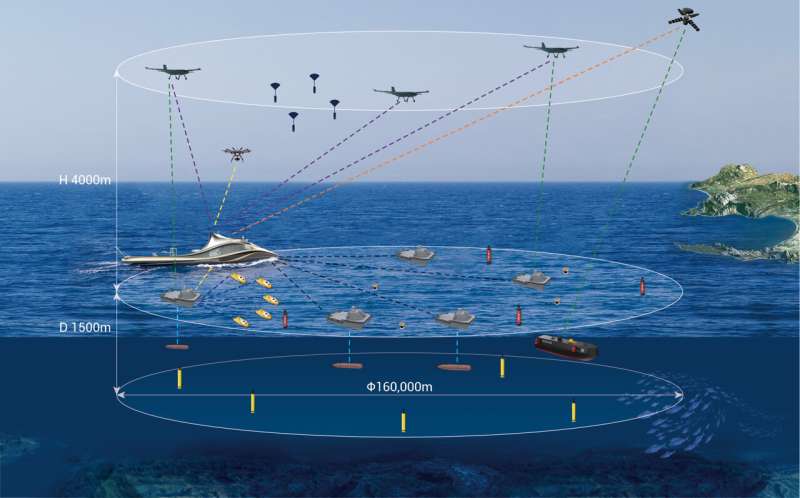
The ocean has always been a force to be reckoned with when it comes to understanding and traversing its seemingly limitless blue waters. Past innovations such as deep-sea submersibles and ocean-observing satellites have helped illuminate some wonders of the ocean though many questions still remain.
These questions are closer to being answered thanks to the development of the Intelligent Swift Ocean Observing System (ISOOS). Using this system, targeted regions of the ocean can be mapped in a three-dimensional method allowing for more data to be gathered in a safer, quicker and more efficient method than existing technologies can achieve.
Researchers published their results in Ocean-Land-Atmosphere Research.
“The basic idea is, using a smart carrier as the mobile system base and control center, to build a cross-domain network of several tens of UAVs [unmanned aerial vehicles], USVs [unmanned surface vessels] and AUVs [autonomous underwater vehicles] for fast, simultaneous, 3-dimensional observation of any targeted regions,” said Chao Dong, researcher and author of the study.
This “crew” of unmanned vessels and vehicles is on-trend with the innovations being made in intelligent autonomous machines which are attractive thanks to their adaptability and flexibility, to name just a couple of qualities. Notably, ISOOS can be key in understanding the role of submesoscale eddies, which are essentially circular currents of water that go against the general ocean current (whirlpools) and happen to be less than 100 kilometers wide.
There is not much known about these eddies right now since they are subject to high variability in space and time. Therefore, a fast scan in the areas they tend to occur can do much more for understanding their occurrences and role in global ocean dynamics than is possible now with existing methods.
Another feat that ISOOS can achieve is ocean floor mapping. Typically this is very time-consuming and expensive, but with the concerted efforts of USVs and AUVs the efficiency in mapping the ocean floor can be increased significantly. For example, a notable recent attempt using AUVs and USVs was the search for the suspected crash of flight MH370. Though no indications of wreckage were found, using the AUVs and USVs 125,000 square kilometers (or 48,262 square miles) of the sea floor was mapped in just under five months.
“In the future, we will try to use ISOOS fulfilling the tasks that are either impossible to approach or inefficient to complete with any existing technologies,” said Dake Chen, corresponding author and researcher.
ISOOS opens up many more avenues of exploration and scientific research when humans do not have to directly be involved in manning the crafts, and instead can be operating or observing the missions remotely. The coordinated efforts of vessels and vehicles used in ISOOS can save countless hours of effort, materials, costs and hardship.
ISOOS also has the potential to be used for searching for wreckage from ships or aircraft, as well as capturing time and space-sensitive oceanic phenomena that would otherwise remain unstudied if traditional methods were employed.
More information:
Chao Dong et al, Intelligent Swift Ocean Observing System, Ocean-Land-Atmosphere Research (2023). DOI: 10.34133/olar.0022
Provided by
Ocean-Land-Atmosphere Research
Citation:
Unmanned and unbothered: Autonomous intelligent oceanic exploration is upon us (2023, October 11)
retrieved 11 October 2023
from https://techxplore.com/news/2023-10-unmanned-unbothered-autonomous-intelligent-oceanic.html
This document is subject to copyright. Apart from any fair dealing for the purpose of private study or research, no
part may be reproduced without the written permission. The content is provided for information purposes only.







